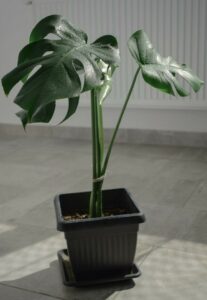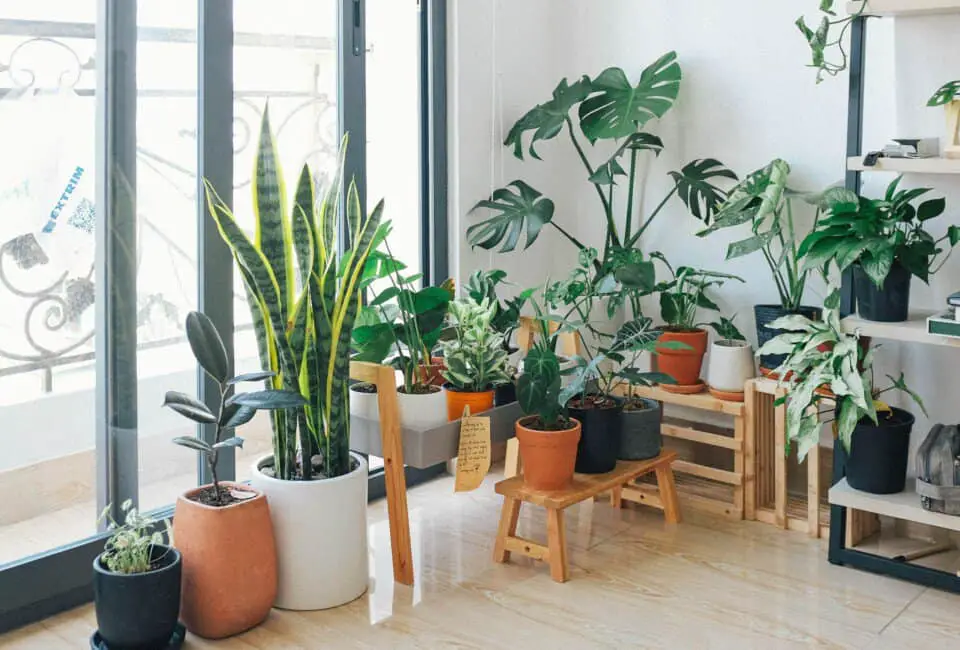Some links in the post are affiliate links and I get a commission from purchases made through some links found in the post.
Are you searching for the best and correct information about the monstera watering schedule?
Let’s talk about the monstera watering schedule in detail. When you get a new houseplant, one of the first things you should do is to research how much and how often it needs to be watered.
Over-and under-watering can cause problems for your plants, such as root rot and fungal growth; however, under-watering can kill your plant beyond repair and cause the leaves to become crispy and brown.
Moreover, this is a very precarious equilibrium!
Now, how much water should you give your brand-new Monstera? How frequently should you water your plants? How can you avoid having problems with watering? What is the monstera watering schedule?
Let’s go over the fundamentals of watering for this lovely plant, the Monstera, which, fortunately, is a fairly tolerant plant.
Ideally for a monstera it does not need a watering schedule, it does not like it when it’s either too dry or too moist, so you need to try and adjust your watering accordingly to keep your monstera within this. They prefer that their soil remains on the border between the two.
I’ll let you in on a little secret: I overwatered my Swiss cheese plant in the past because I followed the advice of the majority of people in the forum and watered it once per week.
However, it turned out that I was the one who made a mistake because I did not take into account other factors, such as the fact that the Monstera plant was in its dormant stage during a very cold winter and would not require as much watering as it normally would.
Monstera Watering Schedule Can Be Affected By a Variety of Factors
Seasonality:
 As I said earlier, the amount of water that Monstera plants need during the Summer as opposed to the Winter is different.
As I said earlier, the amount of water that Monstera plants need during the Summer as opposed to the Winter is different.
Monstera plants enter a state of dormancy during the winter months because the cold temperatures and low humidity are not conducive to the process of photosynthesis.
However, this indicates that the roots do not have to take in as much water as they did previously.
If you overwater the plant at this time, the roots may remain wet for an excessive amount of time, which can result in root rot.
You shouldn’t water the soil to saturation during the Winter. It is recommended to only water the soil sparingly once every two to three weeks or only after it has become completely dry.
Light:
The rate of photosynthesis is maximized in environments where monsteras are exposed to bright, indirect sunlight from windows that face either the south or the east.
These Monstera plants require only an inch of water each week to thrive.
Temperature and Humidity:
The frequency at which water is lost from monstera watering schedule transportation is determined by temperature and humidity.
In response to an increase in the transpiration rate, the roots absorb more water to preserve their turgidity.
Therefore, it is best to shorten the time intervals between waterings to provide the soil with an adequate water supply to sustain the plant.
It would be best if you watered Monstera plants every two to three days in hotter, more humid climates every two to three days.
My friends in Singapore and the Philippines do this with their monsteras, and as a result, I can see that their monsteras are doing very well.
Soil Mixture:
You probably already know that to give this tropical plant the ideal growing conditions, you should steer clear of soil that has been compacted and instead gives it a soil mixture that is both well-draining and aerated.
From the perspective of someone who has made a mistake, here is the deal: Because I used to add an excessive amount of perlite and bark to my soil, it now drains too quickly and does not hold onto the moisture it once did.
Because of this, I had to give my Monstera an almost daily soaking to maintain its hydration. Ultimately, I was forced to repot it into a better potting mix that allowed water to drain and maintained a moist soil environment.
The Pot and the Drainage:
 The frequency with which you need to water your Monstera will vary depending on the size and type of pot you use.
The frequency with which you need to water your Monstera will vary depending on the size and type of pot you use.
Because they allow water to evaporate more quickly, porous containers like terracotta or ceramic help reduce the risk of root rot. On the other hand, this may result in a higher frequency of the need to water your plant.
Although it might appear that a larger pot would naturally be able to hold more soil volume and keep water moisture for a longer period, it is not a good idea to plant your Monstera in a container that is too large for it.
Did you ever wonder why? If the roots of your Monstera have not grown far enough to reach the water on the other side of the pot, the damp soil may attract bacteria that cause root rot. However, this may occur if the roots cannot reach the water.
Propagated Cuttings:
Cuttings of Monstera that have been propagated and planted in the soil will have the same monstera watering schedule as mature Monstera plants.
However, if you grow Monstera cuttings in water, you must change the water every three to five days to avoid fungal infections. If you do not do this, the cuttings will get infected with fungi.
Signs of Improper Watering
Because the amount of water that a Monstera needs can be affected by various factors, it is important to monitor the plant for signs of under-or over-watering, particularly during the first few weeks you own one.
Warning Signs of Being Underwater
When the plant’s whole water supply is used up by transpiration, the leaves lose their turgidity and curl up to prevent any more water from being lost. However, this is done to conserve any remaining water.
Leaves turning yellow and developing brown spots as they dry out
The leaves of plants that do not receive adequate water will show signs of moisture stress and eventually dry out.`
Slow growth
If there is not enough water for the plant, the process of photosynthesis will not work as well, and the plant will not produce enough energy to continue growing.
Fixing a Monstera plant that has been underwatered is as simple as providing it with abundant water and thoroughly soaking the soil until water begins to seep out of the drainage hole.
Signs of Overwatering
- Leaves that have turned yellow are one of the most obvious signs that your Monstera plant suffers from moisture stress from underwatering or overwatering.
- There are dark brown spots on the leaves, probably because root rot has developed due to the plant being overwatered.
- After more than ten days, the ground is still saturated with water. When water is absorbed by poorly drained soil, the ground continues to be wet for longer periods.
- The foul odor commonly associated with soil is thought to be caused by bacteria that thrive in waterlogged soil without oxygen.
- A Monstera plant that is left in soil that has been watered excessively will develop root rot, eventually leading to the plant’s demise.
If the soil has poor drainage, which is causing you to overwater, decreasing the frequency of your watering won’t fix the problem. You must repot your plant in soil that drains better than the current one.
How to Water a Monstera?
The jury is still out on which strategy for watering your Monstera plants will be the most successful in the long run.
Bottom watering is advocated by some, while others insist that top watering is the superior method. Some people like to experiment with both approaches before settling on the one that best meets their needs.
At other times, the circumstances will decide which approach to take. For instance, it may be challenging to provide bottom watering to a large climbing monster housed in a heavy pot.
In contrast, small Monstera plants can be easily moved to the kitchen or counter where they can receive bottom watering.
There are a few things you should be aware of when it comes to watering Monstera plants, regardless of the approach you take.
Use Water at Room Temperature to Water Monstera Deliciosa
However, this prevents the tender roots from being shocked by the cold water. Even though tropical plants are used to sudden downpours, the rain that falls on them is warm, in contrast to the cold water from your tap.
Top Watering Monstera Plants
 The top monstera watering schedule technique is a straightforward process that can frequently be carried out without the plant needing to be moved.
The top monstera watering schedule technique is a straightforward process that can frequently be carried out without the plant needing to be moved.
Although some people find it easier to water their plants by bringing them to the sink, this method isn’t always feasible. The following are the fundamentals of providing supplemental water to a plant.
- Before you water your Monstera Deliciosa plant from the top, ensure that the saucer or catch basin placed underneath the plant pot is large enough to collect the water that seeps through the soil as you water the plant. You can get saucers made of inexpensive plastic designed specifically for this purpose, but you can use any saucer (or even a pie plate) instead.
- Put the water in a pitcher or watering can and put it aside. Watering your plants using this method helps direct the water onto the soil and prevents you from getting water on the foliage.
- Pour the water directly onto the soil in the pot, making sure to distribute it evenly across the space in the container. Be careful not to disturb the dry soil, and pour the water slowly to reach the bottom of the plant pot and exit through the drainage holes. However, this gives the soil enough time to absorb the water as it moves through.
- Give the plant enough water so it is dripping freely through the drainage hole in the bottom of the container, and the soil in the container can be visibly moist.
- After allowing the water to drain for ten to fifteen minutes, empty the water from the catch basin or saucer under the plant pot. If you forget to empty the saucer, the soil in the pot may become waterlogged. Moreover, this prevents oxygen from reaching the roots of your Monstera Deliciosa plant, which can cause the roots to rot.
Bottom Watering Your Monstera Plants
The soil can naturally absorb moisture when Monstera plants are watered from the bottom, but this method requires a little more work.
The following are the primary considerations to keep in mind when bottom-watering Monstera plants:
- Fill a large bowl or bucket with warm water to a depth of several inches, ensuring the bowl or bucket is big enough to accommodate the size of the plant pot.
- Position the Monstera Deliciosa plant so it is submerged in the water in the basin. Be sure that the water level in the plant pot is higher than the bottom of the pot and that any drainage holes are submerged in the water. When watering the roots of your Monstera plants from the bottom up, ensure that any removable saucers on the bottom of your plant pot are submerged in the water.
- Let your plant sit in the water basin until the soil has absorbed enough water through the drainage holes to keep the soil moist from the bottom to the top of the pot.
- Remove the plant from the water and allow any excess water to drain out of the pot via the drainage holes by pulling the plant out of the water. Moreover, this will stop the soil from being saturated with water.
How Long can Monstera Stay in the Water?
 If you water your plants from the bottom, leaving a Monstera in water for up to a few hours won’t hurt it. If you leave it for longer than this, the roots may get hypoxic stress, which could hurt your plant.
If you water your plants from the bottom, leaving a Monstera in water for up to a few hours won’t hurt it. If you leave it for longer than this, the roots may get hypoxic stress, which could hurt your plant.
Even though Monstera doesn’t like to sit in wet soil for long periods, you can permanently grow a plant on a monstera watering schedule.
You can use hydroponics to grow a healthy Monstera plant in water. It would be best to control the temperature, pH, and nutrients to keep your plant healthy.
Final Thoughts
I hope I’ve answered your questions about the Monstera watering schedule and how to water Monsteras and fix any problems you might have.
Don’t worry if something goes wrong with your plants. Part of the fun of growing houseplants is figuring out what went wrong and getting better at taking care of them over time.


